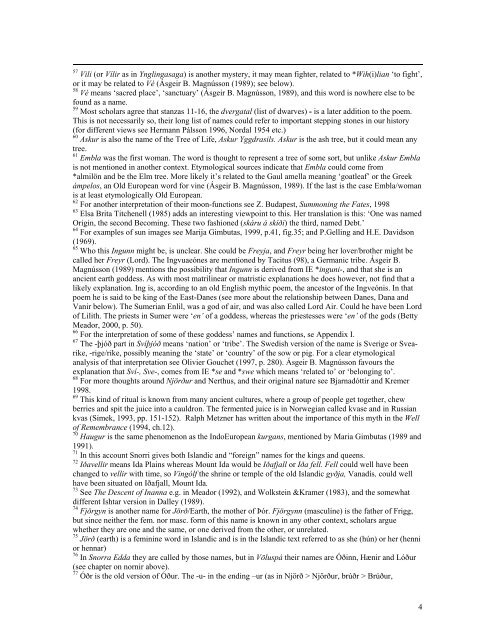Create successful ePaper yourself
Turn your PDF publications into a flip-book with our unique Google optimized e-Paper software.
57 Vili (or Vílir as in Ynglingasaga) is another mystery, it may mean fighter, related to *Wih(i)lian ‘to fight’,<br />
or it may be related to Vé (Ásgeir B. Magnússon (1989); see below).<br />
58 Vé means ‘sacred place’, ‘sanctuary’ (Ásgeir B. Magnússon, 1989), <strong>and</strong> this word is nowhere else to be<br />
found as a name.<br />
59 Most scholars agree that stanzas 11-16, the dvergatal (list <strong>of</strong> dwarves) - is a later addition to the poem.<br />
This is not necessarily so, their long list <strong>of</strong> names could refer to important stepping stones in our history<br />
(for different views see Hermann Pálsson 1996, Nordal 1954 etc.)<br />
60 Askur is also the name <strong>of</strong> the Tree <strong>of</strong> Life, Askur Yggdrasils. Askur is the ash tree, but it could mean any<br />
tree.<br />
61 Embla was the first woman. <strong>The</strong> word is thought to represent a tree <strong>of</strong> some sort, but unlike Askur Embla<br />
is not mentioned in another context. Etymological sources indicate that Embla could come from<br />
*almilön <strong>and</strong> be the Elm tree. More likely it’s related to the Gaul amella meaning ‘goatleaf’ or the Greek<br />
ámpelos, an Old European word for vine (Ásgeir B. Magnússon, 1989). If the last is the case Embla/woman<br />
is at least etymologically Old European.<br />
62 For another interpretation <strong>of</strong> their moon-functions see Z. Budapest, Summoning the Fates, 1998<br />
63 Elsa Brita Titchenell (1985) adds an interesting viewpoint to this. Her translation is this: ‘One was named<br />
Origin, the second Becoming. <strong>The</strong>se two fashioned (skáru á skíði) the third, named Debt.’<br />
64 For examples <strong>of</strong> sun images see Marija Gimbutas, 1999, p.41, fig.35; <strong>and</strong> P.Gelling <strong>and</strong> H.E. Davidson<br />
(1969).<br />
65 Who this Ingunn might be, is unclear. She could be Freyja, <strong>and</strong> Freyr being her lover/brother might be<br />
called her Freyr (Lord). <strong>The</strong> Ingvuaeónes are mentioned by Tacitus (98), a Germanic tribe. Ásgeir B.<br />
Magnússon (1989) mentions the possibility that Ingunn is derived from IE *inguni-, <strong>and</strong> that she is an<br />
ancient earth goddess. As with most matrilinear or matristic explanations he does however, not find that a<br />
likely explanation. Ing is, according to an old English mythic poem, the ancestor <strong>of</strong> the Ingveónis. In that<br />
poem he is said to be king <strong>of</strong> the East-Danes (see more about the relationship between Danes, Dana <strong>and</strong><br />
Vanir below). <strong>The</strong> Sumerian Enlil, was a god <strong>of</strong> air, <strong>and</strong> was also called Lord Air. Could he have been Lord<br />
<strong>of</strong> Lilith. <strong>The</strong> priests in Sumer were ‘en’ <strong>of</strong> a goddess, whereas the priestesses were ‘en’ <strong>of</strong> the gods (Betty<br />
Meador, 2000, p. 50).<br />
66 For the interpretation <strong>of</strong> some <strong>of</strong> these goddess’ names <strong>and</strong> functions, se Appendix I.<br />
67 <strong>The</strong> -þjóð part in Svíþjóð means ‘nation’ or ‘tribe’. <strong>The</strong> Swedish version <strong>of</strong> the name is Sverige or Svearike,<br />
-rige/rike, possibly meaning the ‘state’ or ‘country’ <strong>of</strong> the sow or pig. For a clear etymological<br />
analysis <strong>of</strong> that interpretation see Olivier Gouchet (1997, p. 280). Ásgeir B. Magnússon favours the<br />
explanation that Sví-, Sve-, comes from IE *se <strong>and</strong> *swe which means ‘related to’ or ‘belonging to’.<br />
68 For more thoughts around Njörður <strong>and</strong> Nerthus, <strong>and</strong> their original nature see Bjarnadóttir <strong>and</strong> Kremer<br />
1998.<br />
69 This kind <strong>of</strong> ritual is known from many ancient cultures, where a group <strong>of</strong> people get together, chew<br />
berries <strong>and</strong> spit the juice into a cauldron. <strong>The</strong> fermented juice is in Norwegian called kvase <strong>and</strong> in Russian<br />
kvas (Simek, 1993, pp. 151-152). Ralph Metzner has written about the importance <strong>of</strong> this myth in the Well<br />
<strong>of</strong> Remembrance (1994, ch.12).<br />
70 Haugur is the same phenomenon as the IndoEuropean kurgans, mentioned by Maria Gimbutas (1989 <strong>and</strong><br />
1991).<br />
71<br />
In this account Snorri gives both Isl<strong>and</strong>ic <strong>and</strong> “foreign” names for the kings <strong>and</strong> queens.<br />
72<br />
Iðavellir means Ida Plains whereas Mount Ida would be Iðafjall or Iða fell. Fell could well have been<br />
changed to vellir with time, so Vingólf the shrine or temple <strong>of</strong> the old Isl<strong>and</strong>ic gyðja, <strong>Vanadís</strong>, could well<br />
have been situated on Iðafjall, Mount Ida.<br />
73<br />
See <strong>The</strong> Descent <strong>of</strong> Inanna e.g. in Meador (1992), <strong>and</strong> Wolkstein &Kramer (1983), <strong>and</strong> the somewhat<br />
different Ishtar version in Dalley (1989).<br />
74<br />
Fjörgyn is another name for Jörð/Earth, the mother <strong>of</strong> Þór. Fjörgynn (masculine) is the father <strong>of</strong> Frigg,<br />
but since neither the fem. nor masc. form <strong>of</strong> this name is known in any other context, scholars argue<br />
whether they are one <strong>and</strong> the same, or one derived from the other, or unrelated.<br />
75<br />
Jörð (earth) is a feminine word in Isl<strong>and</strong>ic <strong>and</strong> is in the Isl<strong>and</strong>ic text referred to as she (hún) or her (henni<br />
or hennar)<br />
76 In Snorra Edda they are called by those names, but in Völuspá their names are Óðinn, Hænir <strong>and</strong> Lóður<br />
(see chapter on nornir above).<br />
77 Óðr is the old version <strong>of</strong> Óður. <strong>The</strong> -u- in the ending –ur (as in Njörð > Njörður, brúðr > Brúður,<br />
4


